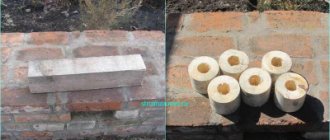Almost any summer cottage allows you to bring a wide variety of ideas to life. So, for arranging and beautifying the territory of a private house, you can use convenient paths made from old tires as decorative elements. There is no need to rush to throw away things that have become unnecessary; you can restore these items and bring something new and original into the design and layout of your summer cottage.
An example of a garden path made from tires
DIY paths made from old car tires will be a unique addition to any country house. Moreover, their use can be completely diverse. From car tires you can make an original frame for the following various garden elements:
- Designing a front garden or flower beds;
- Children's sandboxes;
- A small decorative pool.
Path layout
An already formed area does not require additional planning when constructing paths. In such a situation, roads are laid from point A to point B (from the utility room to the cottage, from the house to the toilet). But if you have not yet decided on the layout of your plot, and you don’t want to walk on wet grass and mud, you should think about what you might need to do, you need to create temporary paths that can easily be removed and moved in the future.
It is also necessary to select the appropriate material and construction technology. Based on the above, you need to plan everything in order to understand where temporary and main garden paths made of tires will be laid, with a good foundation underneath them.
Reference! The width of the path is also considered an important factor in planning. If it is planned to build a fundamental path that will be constantly used, it is necessary to take into account the width; two people must move freely. For such a road, a width of at least 1-1.2 m is required. When constructing paths, it is quite important to take into account the future load, soil characteristics, and groundwater level.
What tools and materials will be needed
To make paths from tires with your own hands between the beds or throughout the entire territory of the dacha, you need to take the following tools:
- sharpened knife, jigsaw;
- shovel;
- hammer, hacksaw;
- roulette;
- pencil;
- ax with nails;
- wooden pegs.
The only materials required are car tires.
Which tires are best to use?
To make paths, they take tires of different sizes - from R13 and larger. Sometimes they use D20 tires from DT.
To avoid difficulties during installation or later when moving along paths, it is recommended to choose small-sized material, preferably from passenger cars.
If there is at least a little tread left on the tires, the paths will not be slippery.
Rules for arranging paths
There are rules that need to be taken into account when arranging roads:
- drainage system (base) - adding sand or sand particles with crushed stone, at least 10 centimeters thick, is used on a loose soil layer. On soil that slowly absorbs moisture, you need to add about 15 cm of crushed stone. Thanks to the above actions, your road will lie on a hard base.
- slope - all roads must be made with a slope, either in one direction, or with a hump on both sides. This is important for steps and platforms; the slope should have the following parameters: one centimeter per meter of path.
- The more the path is loaded, the thicker the base of sand and gravel should be added.
- groundwater - if in your area in the spring after snow melts or after heavy rains the liquid does not drain for a long time, this indicates a high level of groundwater.
There are two solutions:
- We form a cushion of sand and gravel above the ground.
- The second option should be used if there is a ditch or drain.
Let's consider the option of draining water from the surface by laying drainage. Along the edge, on the side where the slope of the path leads, a special pipe is mounted, it runs along the entire path of tires for the garden, and reaches the rain well. After a certain distance, storm water inlets can be placed on the path. It is better to install a drainage type pipe with a slope towards the drain of 1 cm per 1 m of running pipe.
Methods for installing tires for garden paths
There are not many options for installing tire tracks. To create a trail, you can use the following methods:
- lay the tires horizontally;
- pave herringbone shapes.
The choice of installation option will depend on the width and length of the trail, the size of the tires, and their number. It must be taken into account that each option has its pros and cons. For example, tires that lie flat are easier to fill with reinforcing material. But from solid tires you can create not only a garden path, but also a staircase.
When making paths in the garden or at the dacha, you can take both tires with and without rims, in the form of cut strips or squares. It should be noted that in the first case, installation is carried out flat or the tire must be placed “on the edge”.
Advice! To achieve even flooring for paths, you need to use rubber with even wear. It is advisable to choose truck tires.
The vertical installation of tires will be problematic - it requires bedding. It is believed that it is best to fill the gaps between the walls with concrete, which will increase wear resistance. This procedure must be performed before installation itself.
Pros and cons of using tires in path construction
Main advantages of tires:
- Quality. Despite the period of use, the tire remains resistant to temperature changes. Its visual appearance does not deteriorate even during precipitation.
- The trails are easy to maintain. You just need to sweep away the debris and periodically water it with a hose.
- A path made from tires is a safe method of arranging a site. Even after heavy rain, the rubber dries quickly and practically does not slip if you care for it properly.
- The ease of making it yourself is perhaps the main advantage of such a path.
The only disadvantage of this material is that it requires a large amount. But it’s not difficult to buy tires, because now there are many car services.
Creating borders and decor
Creating borders and decoration
To make the garden path more durable, it is also recommended to create a border on the sides. For this purpose, the same tires or tapes based on them will be useful. The border can be made using two methods:
- Use of whole tires . In this case, a small depression is dug in the ground on the sides, which is filled with sand and crushed stone. Then a tire is dug in on top, which is covered with earth, sand and crushed stone. The disadvantage of this approach is that the tire will rise very high above the ground (or you will have to dig a large hole).
- Application of cut tapes. With this option, the master makes ordinary ribbons, and then digs small depressions in the ground on the sides and digs the ribbons in half the width. You can use nails or rubber glue to improve adhesion.
The border and the coating itself can be painted in any color after completing all the necessary work. Any paints will work for painting - enamel, acrylic, nitro paints, and so on. The color can also be any. Please note that the protective coating is applied not after installation, but before it (it is necessary to protect not only the outer surface of the tire, but also the “underground” part of the tire).
Manufacturing methods
There are several options for processing tires, the choice of which depends on skills, availability of tools and preferences. For tracks, it is worth looking for winter tires that are quite resistant to temperature changes.
From whole tires
Using rubber tires, you can make a path on relief terrain. To do this, you will need to figure out the route and the amount of building materials. It is also important that the track is securely fastened to the base. The tires are laid flat on the surface and deepened into the soil layer.
By filling the recesses with turf or a sand-gravel mixture, you can form a staircase-path. To do this, the tires are laid flat, starting from the bottom of the plot and going up. This method will help to lay the material twice as fast and create a pedestrian connection between the necessary points.
You can use tires to lay out a trail alternately in two parallel rows. When wet, the side of the tire begins to slip, so it is better to be more careful if it starts to rain. Such a road can be removed at any time or parts can be swapped to change the design.
You can make a fence from whole tires. To do this you need to throw them on top of each other.
The bottom ball of auto wheels is buried in the soil layer, and the upper rows are strung on wire. Recesses in tires are made using an awl. Such fences are easy to maintain. It can be poured with water and painted in any color scheme.
Country paths made of rubber tiles
This is a completely different level of rubber country coverings. With modular rubber tiles, the area looks expensive and well-groomed.
The coating is created from recycled old tires. The module consists of crumb rubber mixed with colored pigment and a polyurethane binder.
You can lay the tiles yourself. The main thing is to make correct preliminary measurements , outline the length and width of the planned path, and then decide on the location and the required number of tiles.
The thicker the tile, the more expensive it will cost to purchase. However, dense elements can be laid directly on the ground without a backing .
The tile consists of two layers:
- Cushioning – a thick bottom layer of unpainted coarse rubber crumb.
- The top is a thin colored layer of rubber crumb.
It is better to lay thinner tiles (up to 2 cm thick) on a dense surface to avoid unevenness. For example, fill the area where the path is planned with cement, and assemble the elements on top of it.
If you have the tools, you can independently process unwanted tires into crumbs. If you are interested in how to do this, read the article.
Preparatory activities
Before laying out the path, you need to plan everything. It’s better to make a diagram on paper with all the components that complement the trail:
- fencing;
- gutters;
- drainage systems;
- lighting devices.
Important! It is also necessary to measure tires in order to understand how many products will need to be prepared. And this will depend on the length/width of the path, its shape and the route of laying.
How to do the installation yourself - let's look at it step by step
To make a beautiful path from old tires, you need to take a responsible approach to each stage of the work. So, how to make paths in the country from tires, detailed description:
- Preparation of building materials . It is necessary to carefully separate the tire rim from the tread strip. Tool for work - an electric jigsaw or a sharp knife. The rim is separated precisely along the edge of the tread. This will make the cut material easier to straighten. The jigsaw should be driven around the circumference of the tire, and not across it.
- Creating a ribbon . To do this, the protector is cut with a knife. The number of stripes depends on the selected road dimensions.
- Creating the strongest foundation for the trail . A hole is dug to the depth of a spade bayonet. The bottom is compacted. A layer of crushed stone or gravel is poured. From above everything is filled with a sand-cement mixture. But you can do without this. For non-heaving soils, you only need a gravel cushion.
- Alignment and fixation of tapes . It is carried out using treated wooden slats. The edges of the material are straightened and attached to the slats using nails.
Manufacturing and installation of plastic structures and bottles
Paving slabs made from plastic waste
You can also consider making tiles from plastic bottles with your own hands, which is simple and affordable. In particular, there are several key features that should be taken into account:
- Production is carried out in a ventilated room, or one that can be opened to allow fresh air to enter. This is relevant even taking into account that the process is positioned as completely environmentally friendly, which makes it possible to easily ensure a high level of quality and reliability of the coating itself.
This is what plastic paving slabs look like - At the first stage of DIY development, plastic containers are prepared and placed into extruder equipment, where they are subject to crushing. The formed pieces of material are subject to heating while systematically mixing the components.
- After preparing the source material, it is fed into the melting apparatus, where components such as sand, pre-moistened, as well as dye are subsequently supplied.
- Ultimately, a certain viscous mass is obtained; it is this that must be poured into the necessary forms, prepared in advance depending on what the surface of the track should be and its dimensions. After this, the procedure for compacting the composition is performed, for which a press is used.
- After the composition is prepared, it is given the necessary time to cool, after which the form is considered ready for installation. What is noteworthy is that the finished structure is practically no different from conventional concrete or cement compositions, taking into account that the production, in principle, does not differ in anything special. In addition, the finished material can have a fundamentally different shape, color scheme, size and texture.
Decorating paths
Almost all land owners want to expand their territory, not reduce it. Therefore, tips on how to make paths more useful through decoration and visually enlarge them will definitely come in handy.
You need to start by choosing the right vegetation to plant along the path. Lush flowers, voluminous bushes and spreading conifers will take up a lot of space. Therefore, it is better to replace all this with compact vegetation. You can decorate the paths with marigolds, creeping roses and junipers that grow low.
You can also landscape the area along the path with a lawn by simply ordering seeds from the store and planting them in the substrate. You can make a lawn on both sides of the road or on one side, freeing up some space.
Recommendations related to the choice of lighting for roads are also important. Lighting devices should not be large and have many different functions. A good solution is LEDs, duralight strip or small garden lights. These devices have acceptable dimensions and will also help make the path illuminated and safe.
Before planning tire paths for the garden and determining the width of their paving, gardeners must understand that not only the visual appearance of the garden plot, but also its convenience, functionality, and safety will depend on their actions. Therefore, the routes and parameters of each road surface must be plotted and agreed upon before starting construction on the site.
Designing pedestrian paths in the garden
Having a clear idea of where the trail routes should go, cottage owners can begin working on the area. However, if there is no such confidence, before starting active actions they need to start drawing up a project. In the process of routing trails, their parameters should be indicated on the diagram:
- width;
- length;
- form;
- route, etc.
Also at the stage of drawing up the project, issues of using auxiliary and decorative elements are discussed:
- border;
— water drains;
- garden lanterns;
— drainage gutters and other structural items that make the path more practical, functional and safe.
Tire border











